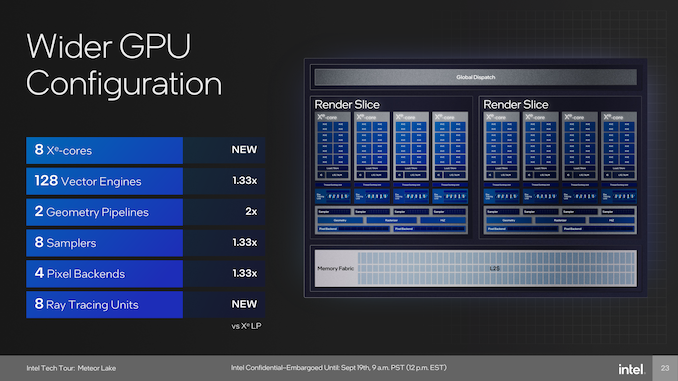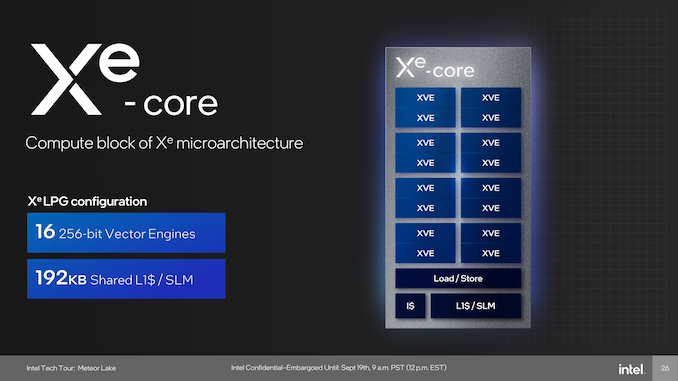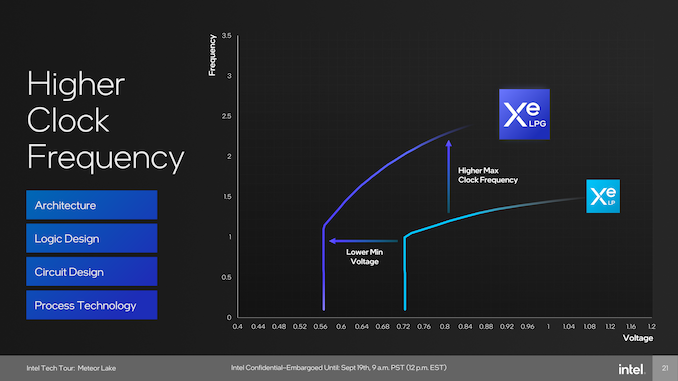Intel Unveils Meteor Lake Architecture: Intel 4 Heralds the Disaggregated Future of Mobile CPUs
by Gavin Bonshor on September 19, 2023 11:35 AM ESTGraphics Tile: A Generational Leap Through Arc, Xe-LPG Graphics
As part of their disaggregated architecture for Meteor Lake, Intel has opted to use a separate tile for graphics. Intel has gone down an interesting route for its disaggregated graphics, with the most notable inclusion through an upgrade to Intel's Arc Graphics architecture. Powering Intel's integrated graphics for Meteor Lake is a new graphics architecture which Intel calls Xe-LPG (and no, we're not talking about fuel here). Based on Intel's current discrete graphics architecture known as Xe-HPG (used in their Arc GPUs), Intel claims 2x performance per watt compared to the Xe-LP architecture-based Iris Xe integrated graphics within Intel's 12th Gen Core series.
There are a number of different elements within the graphics and media area of Meteor Lake, the bulk of which is built into the graphics tile, where the Xe-LPG graphics architecture is located. Unlike the compute tile (Intel 4) and the SoC tile, which is manufactured on TSMC N6 (6 nm), the graphics tile is made on TSMC's N5 node (5 nm), the same generational family as the nodes used by AMD and NVIDIA's discrete and integrated GPUs.
With Meteor Lake and the graphics tile with the Xe-LPG graphics processor, Intel is promising discrete-level performance in an integrated form factor. Looking at the finer specifications, Intel includes 8 x Xe graphics cores with 128 vector engines (12 per Xe core) and 8 samplers, representing a 1.33 x increase over Intel's previous Xe LP graphics. There are also 4 Pixel backends, which is an improvement over the 3 PBs on Xe LP. Intel also doubles the number of geometry pipelines within Xe-LPG, with two, and they also introduce 8 dedicated Ray Tracing Units (RTU), which is new for Intel's integrated graphics line-up.
Looking at the makeup of Intel's Xe core, as previously mentioned, there are 16 Vector Engines that have a bus width of 256-bit, while each core also has 192 KB of shared L1 cache. Each Vector Engine enables 16 FP32 ops per clock, and 32 FP16 ops per clock, with a shared FP64 execution port with 64 INT8 ops per clock. One dedicated FP64 ops per clock unit is new over what's previously been seen in Raptor Lake and shares the overall design philosophy of Meteor Lake on power efficiency; pairs of Vector Engines can run in lockstep for better efficiency.
As part of Intel's goal of advancing the overall experience with Xe-LPG for users, the graphics are DX12 optimized, and Intel now brings Out of Order Samplng (OoOS) to Xe-LPG. It's worth noting that when talking about Execution Units (EUs), Intel's new and current term for this is Xe Vector Engines, or XVE for short. Intel hasn't provided us with how OoOS works within Xe-LPG, but we've reached out for more details.
| Comparing Intel Xe Integrated Graphics (Mobile) | ||||
| Meteor Lake (Xe-LPG) |
Raptor Lake (Xe-LP) |
Alder Lake GT1 (Xe-LP) |
Tiger Lake GT2 (Xe-LP) |
|
| Process Node | TSMC N5 | Intel 7 | Intel 7 | Intel 7 |
| Vector Engines/EUs | 128 | 96 | 96 | 96 |
| ALUs/Shaders | 1024 | 768 | 768 | 768 |
| TMUs | ?* | 48 | 16 | 48 |
| ROPs | ?* | 24 | 8 | 24 |
| Ray Tracing Units | 8 | - | - | - |
| TDP | ? | 15 W | 15 W | 15 W |
*Intel hasn't given us a deep dive into the finer specifications of Xe-LPG integrated graphics. Looking at an existing integrated Intel Arc equivalent with similar specs, the Meteor Lake Xe LPG could have 64 TMUs and 32 ROPs per the Arc A370M, which also has 1024 ALUs.
Comparing Intel's integrated Xe graphics from previous mobile architectures, Meteor Lake, through the Xe-LPG Arc based graphics, has 128 XVEs, which is an increase of 1.33 X or 32 XVE/EUs, than the previous Xe-LP generation. Regarding arithmetic logic units (ALUs), which are essentially shader cores, Xe-LPG has been increased to 1024, which is 128 ALUs per Xe-LPG core. As previously mentioned, Intel hasn't given us more about the finer specifications, including TMUs or ROPs, but does bring 8 Ray Tracing units, which is new for Xe-LPG when compared directly to Xe-LP.
Meanwhile, with Intel's Foveros 3D packaging technology, disaggregating the Media Engine and Display Engine from the graphics tile means when doing encoding or decoding, as well as video playback, it doesn't require the graphics tile to be powered up to do workloads on more power consuming cores.
Intel Xe-LPG is the next step up from Xe LP, and one area where performance and efficiency gains are made is through a lower voltage frequency (V/F) curve, allowing the graphics to run at a lower minimum voltage with a higher maximum core clock speed. Intel has also optimized the pipelines for faster frequencies and is claiming up to 2 x performance at iso-voltages, which for a mobile platform such as Meteor Lake, adds more potential with a key focus on achieving a figure of up to 20% in power savings compared to the previous generation.













107 Comments
View All Comments
kwohlt - Tuesday, September 19, 2023 - link
The market for people who find TB4 to be insufficient is too small to delay MTL for themExotica - Wednesday, September 20, 2023 - link
Source or market research please ? I have the feeling that many enthusiasts will not be interested. Because of missing TB5. And also because of its ipc improvements (or lack thereof) vs raptor lake.Meteor lake certainly is impressive. But it seems to be less about raw performance and more about the process improvement. Foveros. Chiplets. Euv. New manufacturing abilities. AI engine. Power efficiency. Newish gpu.
But from a generational uplift perspective, from a raw cpu performance to the thunderbolt io, I t’s not much of an upgrade for enthusiasts. Intel should’ve just launched MTL in Dec and then announced TB5 in January. What was the reason to announce TB5 before the MTL reveal?
I guess we will have to wait on arrow lake mobile (if that’s a thing) or lunar lake for TB5 on laptops.
kwohlt - Wednesday, September 20, 2023 - link
You need Market Research to tell you TB4 bandwidth is sufficient for majority of users? 40Gb/s can drive easily gigabit interent and multiple monitors. Most jobs do not require more. At the Fortune 500 I manage IT for, we still haven't even switched to thunderbolt as 3.1 docks are more than sufficient.There's market research on TB4 trends for purchase, that i'm not going to pay for, so we'll just have to settle on "Intel's market research determined that delaying their next gen product line for this 1 feature, potentially causing delays across OEMs 2024 product lines in the process, was not worth it"
PeachNCream - Thursday, September 21, 2023 - link
"...many enthusiasts..."While that segment might be outspoken, the percentage of the overall market is tiny and the percentage that cares among that fraction is even smaller. Basement dweller computer nerds and the e-sports people they idolize don't buy the hundreds of thousands of units that a computer manufacturer purchases. Sure, they get a minor head nod from the company to keep them from slobbering and raving about being ignored, but that's done because it's cheap to coddle them with marketing speak and make them believe features are targeted at them so their ego balloons aren't popped and sites like this have a bone or two to throw them once in a while, but ultimately, no one cares what they want as long as they fanboy argue in favor of their preferred brand with other nerds that like the competition.
TheinsanegamerN - Thursday, September 21, 2023 - link
Exactly. TB5 is exciting and meteor lake is mostly DoA without it. Who would invest thousands into a machine that cant make use of newer functionality?KaarlisK - Tuesday, September 19, 2023 - link
Was this just written by having an AI interpret the slides? And then OCR failed?"This means that higher Out-of-Service (OoS) work is allocated to P-cores for more demanding and intensive workloads, while lower Quality-of-Service (QoS) workloads are directed to E-cores, primarily to save power"
Ryan Smith - Tuesday, September 19, 2023 - link
No, it was done by a sleep-deprived human.KaarlisK - Tuesday, September 19, 2023 - link
Thank you for the explanation.The problem is, I caught at least three more mistakes like this, where a wrong assumption is made about what the text on a slide actually means. In which case (knowing that I'm not an expert), how can I be certain that there aren't many more mistakes that I haven't spotted?
We do come to Anandtech for in-depth analysis, which requires that trust.
Ryan Smith - Tuesday, September 19, 2023 - link
The blunt answer is that we're imperfect (to err is human). We've made mistakes in the past and will continue to do so in the future. But we always own up to those mistakes, and will correct anything if we catch it (or if it gets pointed out).DannyH246 - Tuesday, September 19, 2023 - link
Wow! Intel have some revolutionary ideas here!! Their chiplet approach will change the industry.Would be what i'd have said if they'd have presented this 6 years ago. My response today is...meh.